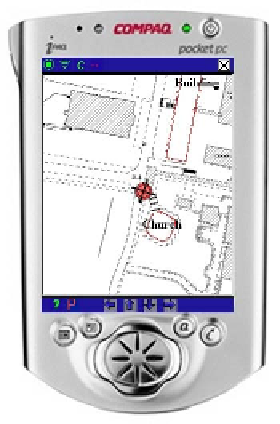Information Technology Reference
In-Depth Information
Fig. 5.
Genie locates user adjacent to the church (left) and assembles and displays a
Presentation for the Church on the Campus (right).
Meeting such expectations within the confines of limited devices and the limited
bandwidth availability of wireless networks, particularly the cellular variety, is
dicult. In an effort to address this, the Genie adopts a strategy that has been
termed intelligent pre-caching [25]. In brief: a model of the tourist's environment
is maintained which contains, amongst other things, specific details of the various
tourist attractions within it. If this model is considered in light of the tourist's
spatial context, that is, their position and orientation, as well as their personal
interest profile, their likely future behavior can be estimated with a reasonably
high degree of certainty. Therefore, the appropriate content can be downloaded
to their device in just-in-time basis. As this content is inherently adapted to the
tourist's context, as well as personalized to conform to their individual profiles,
a satisfactory experience may be reasonably anticipated.
3.3 Architecture
In essence, Gulliver's Genie comprises a suite of agents residing both on the client
and on the server. Currently some of these agents are mobile and based upon a
given technological context they may autonomously decide where to reside. All
these agents collaborate to deliver the necessary services to the tourist (Fig. 6).
Each agent is now briefly described:
Spatial Agent.
To determine a tourist's spatial context, this agent autonom-
ously monitors the GPS signal and interprets it accordingly. This, it periodically
broadcasts to other interested agents. This agent is unique in that it harnesses
its capacity to migrate. Though GPS is the de facto standard for position deter-
mination at present, systems using cellular network techniques are envisaged in


Search WWH ::

Custom Search